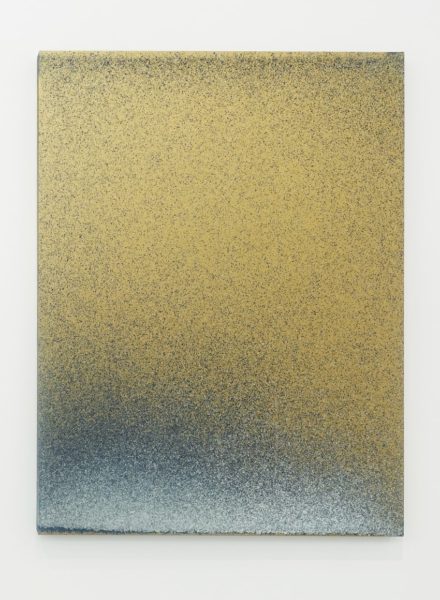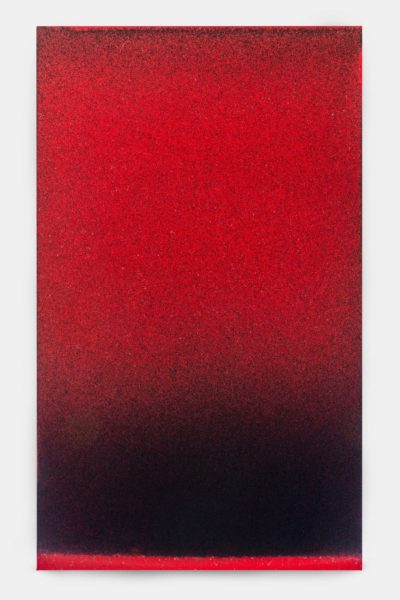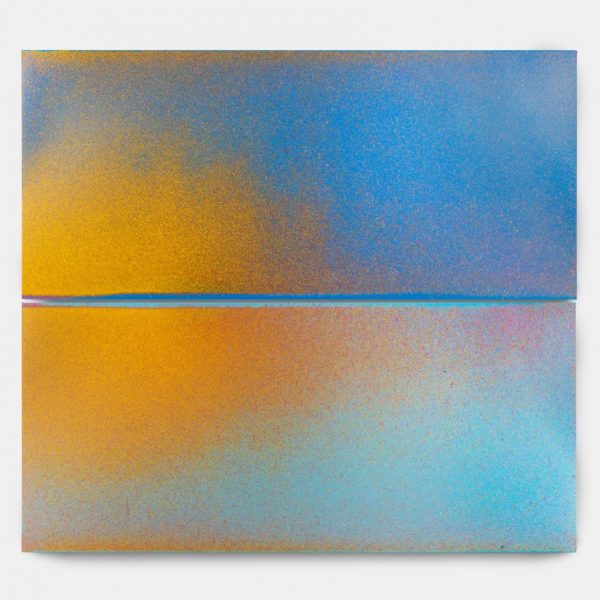John Knuth: The Origin of the New World. (link to video).
On the opening night of The Origin of the New World, audiences came out in droves to Hollis Taggart Gallery at 507 West 27th Street to see and hear what the high buzz was all about. One could then deduce that guaranteed levels of uncertainty are fundamental to the visual language of Knuth’s methods of production and final resolution – imagery which ostensibly disrupts predetermined approaches to painting. In actuality, a mass of swarming flies is responsible for producing the imagistic components in Knuth’s recent series of paintings, drawings and globes. To render the works to completion, multitudes of minute particles of regurgitated flyspeck, comprised of digested acrylic paint, accumulate on the primed and unprimed surfaces in varying tonal and color range. Tactility is therefore realized as an aftereffect as the constitutional compounds and compositional formations of these resultant marks, or “particles,” allude to the limitless observations derived from chronicled studies of the cosmos and/or origins of the universe. Curated by Paul Efstathiou, The Origin of the New World is John Knuth’s first solo exhibition in New York City.

The onset of momentary, dipteran enactments on Knuth’s dimensional globes and flat surfaces furthers inferences to historical cartographies as well as to former conceptions of Old World / New World dichotomies and dominate his compositions. The strongest of the formats presented are his elongated vertical and horizontal canvases which indubitably create parallels to the aforementioned, particularly to the genre of landscape, in which their symbolic meaning is reasserted in many of Knuth’s title assignations. For instance, a geographic synergy specific to the prior romantic envisioning of the Americas as a continent and its demarcation as the “New World” appears to be embedded in such content formations as “Ellis Rise,” “Manhattanhenge,” and “New Gold.”

Both his diptychs and singular paintings emphatically reference antecedents from the Hudson River School, such as the Tonalist, Albert Pinkham Ryder, who held strong affection for invoking the visual power in transcendent light and atmosphere in his paintings of the region. Other kinships seem to include the American Modern painters Mark Rothko and Agnes Martin, whose minimal compositional arrangements suggest landscape rather than any overt representation and evoke emotion while tendering universal harmonies.

Akin to the aforementioned artists and oeuvres, Knuth’s restricted usages of color create the spatial potential for a highly sensitized and intimate form of communication with the viewer. Employing an emotional approach to light and color evocative of Color Field painting, Knuth’s work similarly demonstrates a deep affection for resplendent surfaces. One such precedent, “Redhook Blackout,” leaves an ominous impression that epitomizes yet simplifies Mark Rothko’s play with gravity in “Four Darks in Red” from the 1950s in which Rothko juxtaposed saturated reds and blacks on his horizontal support. Illustrated here and in several other paintings and drawings in the exhibition, an irregularity at the edges creates a discontinuity that allows one to then experience subsequent levels of proximate saturation. This subtle approach to the picture frame visually redirects the viewer to shallow space whilst inculcating a more internalized experience.

In keeping with the aforementioned, one is likewise reminded of pictorial photography which sought to emphasize experiments in exposures and printing so as to enhance atmospheric effects and tonal fluctuations. Through an amplified lens, Knuth’s unique visuals parallel the photographic processes thus mentioned and assume nuances that enable access across a wide-ranging stratum of viewership. Such minimal, luminescent treatments displayed in “Ellis Rise” gain greater amplitude through the visual drama induced by shifting perceptions of depth and surface. At an established distance from the painting, one perceives large sections of blur produced by the complement of solid, rectangular underlayers that serve as virtual color bars. Large gaps of space, such as the gulfs and divisions between assumed earth and sky, advance such connotations and call forth a historical romanticism. Along these lines, the rectangular, floating fields of color register as an otherworldliness. Moreover, these formal qualities prioritize the means for the bifold comprehension of one’s internalized and externalized worlds.
Using New York City as a metaphorical backdrop, concerns for universality and the subjective potential of the artist that drove much of modern abstract painting is hinted at in this reductive yet satiating series. Analogous to Color Field Painting which aimed to entirely absorb the viewer through methods of abstraction, Knuth’s misty, diaphanous forms induce plenty of psychological presence. Given its penchant for performative spectacle along with its interjection of insects as a correlation to “creationism,” The Origin of the New World summonses an implicit value for the experience of everyday life as it simultaneously engenders the work with aspects of perpetual renewal.
JOHN KNUTH: THE ORIGIN OF THE NEW WORLD
Hollis Taggart Gallery
507 West 27th Street
June 8 – 29, 2019
